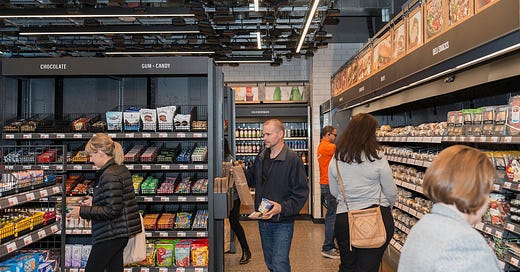Healthy Choices, Healthy Minds: Reforming Convenience Store Culture
The spaces our students rely on for food and snacks are filled with nutritionally deficient options, with disastrous consequences for public health.
![Health-Focused 'KaleMart24' to Launch in Canada to Disrupt Convenience Store Retail [Interview] Health-Focused 'KaleMart24' to Launch in Canada to Disrupt Convenience Store Retail [Interview]](https://substackcdn.com/image/fetch/$s_!SYbk!,w_1456,c_limit,f_auto,q_auto:good,fl_progressive:steep/https%3A%2F%2Fsubstack-post-media.s3.amazonaws.com%2Fpublic%2Fimages%2F69200b29-4c99-4bc7-8e6a-db88cc652a1a_2048x1364.jpeg)
By Isabella Coronado Doria
The first image that comes to mind when thinking about Canadian snacking culture is a sleep-deprived, slightly lonely, and overwhelmed university student. Typically they are walking out of a Couche-Tard at 9 PM, an energy drink in one hand and a family-sized bag of chips in the other. This disheartening image perfectly illustrates the situation of many university students. Due to a lack of time and the stress of academic responsibilities, they have adopted eating habits that harm their health. These behaviors are out of necessity, a consequence of the lack of availability of healthy options at affordable prices. In order to curb these behaviours, there is an urgent need for convenient, accessible, affordable, and healthy options in convenience stores.
In Canada, convenience stores or depanneurs are an integral part of the culture. These spaces, found on every corner, are a staple of the busy lifestyle that characterizes many of this country’s cities. Students, in particular, prefer these places because they are convenient, usually accessible, and because the products they offer are typically ready-to-eat. For many of these students, especially during exam periods, convenience stores may even represent their primary source of food during the day: a quick energy drink for breakfast, a cold 3-day old cheese sandwich for lunch, and a bag of chips for dinner.
Despite the importance of these corner stores in the daily lives of those we consider to be the future of this country (and the world), they are often saturated with snack options that have little to no nutritional value, while healthier and more nutritious alternatives are glaringly absent — or prohibitively expensive.
The problem with the lack of availability of healthier options is that it leaves students with no choice but to turn to junk foods. We have allowed the spaces our students rely on for food and snacks to be filled with nutritionally deficient options, condemning them to choose the lesser evil among the bad choices because there is nothing else available to them.
Although there is nothing wrong with consuming processed foods and sugary drinks occasionally, students often incorporate them into their daily routines, cultivating habits that harm their health. According to the World Health Organization A diet high in ultra-processed foods is correlated with nutritional deficiencies, disordered eating behaviors, a higher risk of cardiovascular issues, hormonal and metabolic disorders, poor cognitive function, to name but a few detrimental effects. This implies that by failing to provide better and healthier options, we are compromising students' health both in the short and long-term.
Advocating for change is urgent, and the responsibility falls on all of us. Just as with car safety or anti-tobacco movements, changing institutions that uphold the status quo requires promoting cultural shifts. In this case, for instance, it could involve demanding new options from the convenience store in your neighborhood or school, or pushing universities to implement policies that avoid partnerships with companies that don't include healthy options on and off campus. Calling for stricter regulations to reduce advertising for ultra-processed products, sugary drinks, and similar items, as well as advocating for subsidies to make healthy options competitively priced.
Ensuring profitability must be a key pillar in the push for advocacy. Our ability to improve health outcomes for students should in no way represent a disproportionate burden on another group, such as corner store owners and employees. Additionally, it’s important to remember that when we talk about healthy options, we’re not referring to a browning banana at the back of the store, but rather to options that share the same characteristics that make convenience store products popular: convenience, low prices, and ready-made. This is why incentives for innovation and creativity are also key. For instance, Kalemart 24, a new convenience store in Montreal, has successfully integrated healthy alternatives while maintaining affordability and accessibility, proving that profitability and well-being can go hand in hand.
The lack of healthy options in convenience stores remains a critical issue affecting the well-being of university students. As these stores serve as a primary food source for many, it is urgent to advocate for healthier, affordable alternatives that offer the same convenience and accessibility as the products currently sold. By advocating for change, we can help students adopt better eating habits that will benefit their long-term health which in return benefits overall society especially in places like Canada where the healthcare system is paid for by the public. It’s not just about changing what’s available in stores, but also shifting the snacking culture to one that prioritizes student health and empowers people to make better food choices while maintaining profitability for corner store owners.
Isabella Coronado Doria is a Deputy Editor of The Bell. Born on the Caribbean coast of Colombia, she is an economist and professional in Government and Public Affairs from the Universidad de los Andes. Before joining Max Bell, she worked as a project assistant to the President of the Universidad de los Andes, where she implemented strategic improvement projects and managed communication between the president's office, students, and parents. Isabella's strong interest in evidence-based educational public policy has led her to work as a research assistant on various projects. Additionally, she has volunteered with education-oriented non-profit organizations in Colombia, supporting their initiatives to improve learning communities.



